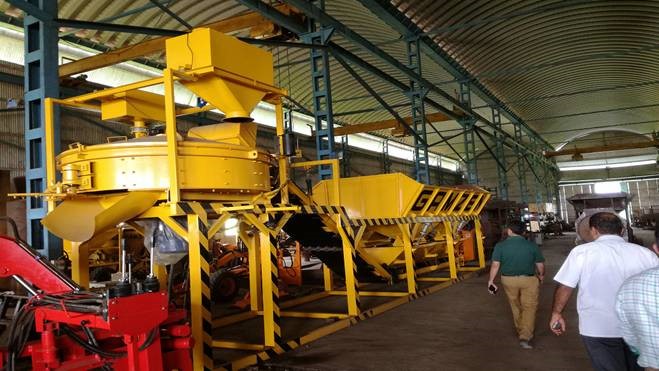Concrete Batching Plant 101: A Beginner’s Guide to Boosting Your Construction Productivity
Construction projects demand efficient and reliable processes to ensure timely completion and superior quality. One crucial aspect of any construction endeavor is the production of high-quality concrete. This is where a concrete batching plant comes into play. In this comprehensive guide, we will take you through everything you need to know about concrete batching plants and how they can significantly enhance your construction productivity.
In the realm of construction projects, concrete plays a pivotal role as the backbone of structures. Concrete batching plants are essential facilities that enable the production of concrete in large quantities, allowing construction teams to meet project demands efficiently. This guide aims to provide a beginner-friendly overview of concrete batching plants, their types, advantages, operational considerations, and ways to boost productivity.
What is a Concrete Batching Plant?
A concrete batching plant, also known as a concrete mixing plant or a batch plant, is a specialized facility designed to produce concrete in large quantities. It combines various ingredients such as cement, water, aggregates (sand, gravel, or crushed stone), and additives, following specific ratios to ensure the desired concrete mix is achieved. Batching plants are available in various configurations to cater to different project requirements.
Types of Concrete Batching Plants
There are primarily three types of concrete batching plants: stationary, mobile, and compact. Each type offers distinct advantages and is suitable for specific applications.
- Stationary Batching Plants: These plants are permanently located at a construction site and are designed for high-volume production. They offer excellent productivity, advanced control systems, and a wide range of customization options.
- Mobile Batching Plants: As the name suggests, mobile batching plants are portable and can be easily transported to different job sites. They are ideal for small to medium-sized projects that require frequent location changes.
- Compact Batching Plants: Compact plants are designed to provide a balance between high productivity and mobility. They occupy less space compared to stationary plants and are suitable for projects with space constraints.
Advantages of Using a Concrete Batching Plant
Concrete batching plants offer several advantages that significantly contribute to boosting construction productivity. Let’s explore some of the key benefits:
- Increased Productivity and Efficiency: Batching plants ensure a continuous supply of fresh concrete, eliminating delays and reducing downtime. This streamlined production process allows for faster construction progress and increased overall productivity.
- Consistent Quality Control: Batching plants enable precise control over the concrete mix composition, ensuring consistency and uniformity. This results in high-quality concrete with predictable strength and durability, meeting stringent project specifications.
- Reduced Labor and Material Costs: Automated batching systems minimize manual labor requirements, reducing the workforce needed for concrete production. Additionally, optimized material usage reduces wastage, resulting in cost savings.
Factors to Consider When Choosing a Batching Plant
When selecting a concrete batching plant for your construction project, several factors should be taken into consideration:
- Project Requirements: Evaluate the specific requirements of your project, such as the required concrete volume, mix design, and delivery schedules.
- Production Capacity: Determine the volume of concrete you need to produce per hour or per batch to select a plant with the appropriate capacity.
- Site Conditions and Available Space: Assess the construction site’s layout, available space, and accessibility to choose a plant that fits well and optimizes workflow.
- Cost Considerations: Consider the initial investment, operating costs, and potential return on investment (ROI) when selecting a batching plant. Find the right balance between cost and desired features.
Setting Up a Concrete Batching Plant
Proper setup and installation of a batching plant are crucial for its optimal performance. Here are the key steps involved in setting up a concrete batching plant:
- Site Preparation and Layout Design: Prepare the site by leveling the ground, ensuring proper drainage, and establishing the layout for equipment placement, material storage, and concrete mixer positioning.
- Installation and Calibration of Equipment: Install the batching plant components, including the cement silos, aggregate storage bins, conveyors, mixers, and control systems. Calibrate the equipment to ensure accurate measurement and mixing.
- Safety Measures and Environmental Considerations: Implement safety protocols, such as fencing, signage, and emergency stop systems, to protect workers and prevent accidents. Consider environmental factors, such as dust control measures and proper waste management.
Operating a Concrete Batching Plant
To ensure optimal performance and productivity of a concrete batching plant, operators need to follow certain guidelines:
- Batching Process and Control Systems: Understand the batching process, including the sequence of adding materials, the mixing duration, and the control systems. Monitor and adjust the parameters as necessary to maintain the desired concrete quality.
- Maintenance and Troubleshooting Tips: Regularly inspect and maintain the plant’s components, such as the mixer blades, conveyor belts, and electrical connections. Address any issues promptly to prevent downtime and ensure smooth operations.
- Best Practices for Optimal Performance: Implement best practices like cleaning the equipment after each batch, conducting routine calibration checks, and training the operators to operate the plant efficiently.
Enhancing Productivity with a Concrete Batching Plant
While a concrete batching plant inherently boosts construction productivity, certain strategies can further enhance its effectiveness:
- Proper Scheduling and Logistics: Develop a well-defined schedule for concrete production and delivery to minimize waiting times and maximize utilization. Optimize logistics to ensure efficient material handling and transportation.
- Efficient Material Handling and Storage: Organize the material storage area for easy access and quick retrieval. Implement efficient material handling systems, such as conveyor belts or skip hoists, to streamline the flow of aggregates and cement.
- Training and Skill Development for Operators: Provide comprehensive training to plant operators, covering equipment operation, maintenance procedures, and troubleshooting. Continuous skill development ensures the operators can handle the plant effectively.
Common Challenges and Solutions
Concrete batching plants may face certain challenges during operation. Here are some common issues and their potential solutions:
- Concrete Slump Variations: Inconsistent slump affects the workability of concrete. Use admixtures, such as water reducers or plasticizers, to control the slump and maintain consistency.
- Aggregate Segregation: Poorly designed or overloaded batching plants may result in aggregate segregation. Regularly inspect and calibrate the equipment, ensuring proper mixing and uniform distribution of aggregates.
- Equipment Breakdowns and Maintenance Issues: Conduct regular maintenance and servicing to minimize the risk of equipment breakdowns. Keep spare parts readily available to quickly address any unforeseen issues.
Future Trends in Concrete Batching Plants
The concrete batching plant industry is evolving, with several exciting trends shaping its future:
- Automation and Advanced Control Systems: Automation technology, including computerized control systems and batch management software, allows for precise control, real-time monitoring, and data-driven decision-making.
- Integration of Digital Technologies: Digital solutions, such as IoT sensors, predictive analytics, and remote monitoring, enable improved plant performance, predictive maintenance, and efficient resource utilization.
- Sustainability and Eco-friendly Practices: Concrete batching plants are embracing sustainable practices, such as using recycled aggregates, incorporating water recycling systems, and optimizing energy consumption to reduce their environmental footprint.
Conclusion
Concrete batching plants play a crucial role in construction projects by providing a consistent supply of high-quality concrete. Understanding the different types of plants, their advantages, and operational considerations is essential for boosting construction productivity. By selecting the right batching plant, following best practices, and embracing future trends, construction professionals can optimize their concrete production processes and achieve superior project outcomes.
FAQs
- How long does it take to set up a concrete batching plant?
Answer: The duration depends on various factors, including the plant size and complexity. Typically, it can take several weeks to set up a batching plant.
- Can a mobile batching plant be used for large-scale construction projects?
Answer: Mobile batching plants are more suitable for smaller to medium-sized projects. For large-scale projects, stationary plants are generally preferred due to their higher production capacities.
- What measures can be taken to prevent concrete slump variations?
Answer: Proper mix design, accurate measurement of ingredients, and the use of admixtures can help control and maintain consistent concrete slump.
- Are there any environmental regulations for operating a batching plant?
Answer: Environmental regulations vary by location. It is essential to comply with local laws and regulations regarding noise control, dust suppression, and wastewater management.
- Can a batching plant be customized to meet specific project requirements?
Answer: Yes, batching plants can be customized based on project requirements. Manufacturers often offer customization options for equipment configuration, automation level, and additional features.

